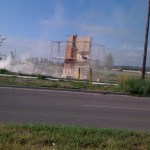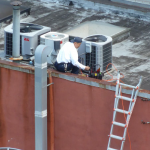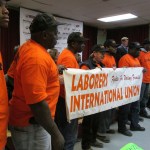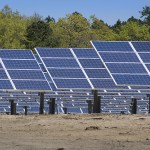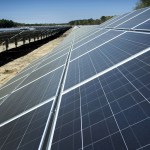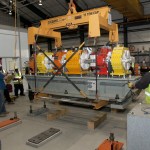construction
The Pump Handle is on a holiday break. The following, which was originally published on May 23, is one of our favorite posts from 2016.
by Kim Krisberg
Last summer, 25-year-old Roendy Granillo died of heat stroke while he installed flooring in a house in Melissa, Texas, just north of Dallas. His tragic and entirely preventable death marked a turning point in advocacy efforts to pass a rest break ordinance for local construction workers.
About five months after Granillo’s death, the Dallas City Council voted 10-5 to approve such an ordinance, which requires that construction workers be given a…
Last summer, 25-year-old Roendy Granillo died of heat stroke while he installed flooring in a house in Melissa, Texas, just north of Dallas. His tragic and entirely preventable death marked a turning point in advocacy efforts to pass a rest break ordinance for local construction workers.
About five months after Granillo’s death, the Dallas City Council voted 10-5 to approve such an ordinance, which requires that construction workers be given a 10-minute rest break for every four hours of work. On its face, it seems like an incredibly simple and logical request, especially considering the…
Today, the Centers for Disease Control and Prevention released new data on heat deaths among U.S. workers, underscoring the often-tragic consequences that result when employers fail to take relatively simple and low-cost preventive actions.
Published in today’s issue of CDC’s Morbidity and Mortality Weekly Report (MMWR), researchers reviewed two years worth of OSHA enforcement cases that were investigated under its general charge to uphold safe and healthy workplaces. (OSHA investigates workplace heat illness and death via the “general duty clause” of the Occupational Safety and Health Act of…
Occupational health hazards are often hidden, and may not even be appropriately disclosed to workers who are exposed. They are usually shielded from public view, meaning they don't get the attention needed to ensure protections are put in place to address them. But every once in a while, hazards to workers' health are right in front of you.
Yesterday morning, I was driving on FM 1626 in Kyle, TX and passed this scene: Two construction workers standing in a nasty cloud of dust. The men were working at the new campus of Austin Community College in Hays County, TX and…
For this Workers' Memorial Week, the National Coalition for Occupational Safety and Health (National COSH) has released "Preventable Deaths: The Tragedy of Workplace Fatalities," a report that tells the stories of six workers killed on the job and promotes solutions to prevent other workers from sharing similar fates. The report notes that in 2011, 4,609 workers were killed, and construction was the deadliest industry sector, with 721 worker fatalities. The report tells the story of one construction worker killed on the job:
One day in April 2009, Orestes Martinez (29) and two co-…
by Kim Krisberg
"To know you participated in building something in your city — it's just an experience, you know?"
Those are words from Austin, Texas, native Christopher McDavid, 22, a graduate of the city's newly established Construction Career Center. During his time at the center, McDavid got certified in flagger safety (flaggers direct the safe passage of traffic through construction areas), first aid and CPR, and basic concrete work and received his OSHA 10 certification, which he said "has opened my eyes to actually see the things that can be harmful to me."
Now, McDavid is looking for…
by Kim Krisberg
Workers in Travis County, Texas, are celebrating what advocates are calling a landmark victory, after local leaders voted to ensure that economic incentive deals benefit both big business and workers.
In late November, Travis County commissioners approved a new living wage requirement for companies wanting to move into the county and take advantage of the generous tax breaks the region offers to lure new business. The requirement creates a new wage floor of $11 an hour for all employees, including construction workers. On the same day as the county vote, a committee of the…
by Kim Krisberg
It's Tuesday evening and as usual, the small parking lot outside the Workers Defense Project on Austin's eastside is packed. The dusty lot is strewn with cars and pick-up trucks parked wherever they can fit and get in off the road. I've arrived well before the night's activities begin, so I easily secure a spot. But my gracious guide and translator, a college intern named Alan Garcia, warns me that I might get blocked in. It happens all the time, he says.
It was the first of two August evenings I'd spend observing the project in action and meeting the workers who help lead its…
by Kim Krisberg
Last month, more than 70 ironworkers walked off an ExxonMobil construction site near Houston, Texas. The workers, known as rodbusters in the industry, weren't members of a union or backed by powerful organizers; they decided amongst themselves to unite in protest of unsafe working conditions in a state that has the highest construction worker fatality rate in the country.
The workers reported multiple problems with the ExxonMobil subcontractor who hired them, including not being paid on time, not having enough water on site and no access to medical care in the event of an…
by Kim Krisberg
When most of us think of sustainability and construction, the usual suspects probably come to mind: efficient cooling and heating, using nontoxic building materials, minimizing environmental degradation — in other words, being green. But in Austin, Texas, a new effort is working to expand the definition of sustainability from the buildings themselves to the hands that put them together.
Launched about a year ago, the Workers Defense Project's Premier Community Builders program certifies major new developments as sustainable for workers. That means making sure construction…
This guest post was written by Pat Looney, chair of the Sustainable Energy Technology Department at the U.S. Department of Energy's (DOE) Brookhaven National Laboratory.
If the sun is shining over Long Island, NY, as you read this article, the Long Island Solar Farm (LISF) is generating enough clean solar energy to power as many as 4,500 homes for the Long Island Power Authority (LIPA).
Construction of the LISF at Brookhaven National Laboratory (BNL) began in the fall of 2010 and officially concluded this month when the array began commercial operation. LIPA hosted a formal commissioning…
Margarito Guardado Resinos, 34, and Nelson Pineda were working together to erect a pre-engineered steel building frame at a construction site in San Marcos, TX. The two were employed by Jetka Steel Erectors of Katy, TX, a firm hired by Bailey Elliot Construction of Austin to erect a new building for Thermon Manufacturing at the central Texas location. (I moved to San Marcos, TX last fall and the Thermon facility is on the service road for I-35, only a few miles from my home.) Just before noon on July 27, 2011 the metal structure collapsed, killing Mr. Resinos and injurying Mr. Pineda.…
Brookhaven will soon be home to the largest solar farm in the eastern United States. The Long Island Solar Farm, being constructed by BP Solar and the Long Island Power Authority on Brookhaven Lab's campus, will produce 32 megawatts of power when complete - enough to power about 4,500 homes.
The Long Island Solar Farm
Just about six months after site preparation work began in November, the farm is now more than halfway complete. To date, workers have mounted nearly 90,000 of the 164,000 solar panels that will make up the array and have installed 4,600 of the 6,800 racks that hold the…
Construction on Brookhaven's National Synchrotron Light Source II (NSLS-II) -- which will allow scientists to explore everything from fuel cell catalysts and soil samples to molecules vital for human life -- has passed the 50-percent completion mark.
The NSLS-II construction site
Work on the half-mile electron racetrack began in 2009 and is now more than a year ahead of schedule. In addition, conventional construction -- which covers everything from the roof and concrete floors to the plumbing and electricity -- is now complete on the first fifth of the ring. This milestone gives the…
The steel framework that will house Brookhaven's National Synchrotron Light Source II (NSLS-II) is almost a complete, nearly half-mile ring after the last piece of structural steel was ceremonially signed yesterday afternoon.
Construction workers, Brookhaven employees, and elected officials signed the last remaining piece of structural steel for the NSLS-II ring. This milestone is known as "topping out" in the construction industry.
Just how big is this scientific circle? Big enough to fit the playing field of Yankee Stadium inside -- with so much extra room that you might never see a home…
Earlier today, OSHA published its long-awaited final rule on cranes and derricks in construction. We've been following this rule's slow progress for two years now, since a March 2008 crane collapse at a New York construction site killed six workers and a tourist. At the time, Celeste pointed out, "OSHA acknowledges that as many as 82 workers are killed each year in crane 'accidents,' and that the 1971-based crane safety standard is outdated."
OSHA actually looked like it was addressing this issue back in 2003, when it established a negotiated rulemaking committee (which included…
A little more than one year ago, on the day of its groundbreaking ceremony, the National Synchrotron Light Source II (NSLS-II) construction site was nothing more than a whole lot of dirt. Today, it's...well, take a look for yourself.
The NSLS-II construction site on the day of the groundbreaking ceremony, June 15, 2009, and...
...exactly one year later
Construction is quickly progressing on the $912 million facility, which will be the world's most brilliant light source. Eh, what's a "light source?" Basically, it's a particle accelerator that, in a controlled manner, sheds light of…
I'm having a little trouble typing, because the temperature in my office at the moment is around 55 F, and my hands are getting really cold. This is because of "deferred maintenance," which means "we're saving money by not maintaining the air-handling systems in our academic buildings (among other things)." The budget has been tight every year since I got here, and this building is fairly old, so things don't work as well as they might.
The background noise while I'm typing is the sound of construction on the new Wold Building (webcam link). This is a multi-million-dollar new building…
